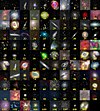NGC 1275
| Galaxy NGC 1275 |
|
|---|---|

|
|
| Photo from the Hubble Space Telescope | |
| AladinLite | |
| Constellation | Perseus |
|
Position equinox : J2000.0 , epoch : J2000.0 |
|
| Right ascension | 03 h 19 m 48.1 s |
| declination | + 41 ° 30 ′ 42 ″ |
| Appearance | |
| Morphological type | cD; pec; NLRG; Sy2; LEG |
| Brightness (visual) | 11.7 mag |
| Brightness (B-band) | 12.7 mag |
| Angular expansion | 2 ′, 3 × 1 ′, 6 |
| Position angle | 110 ° |
| Surface brightness | 13.0 mag / arcmin² |
| Physical data | |
| Affiliation | Perseushaufen , Abell 426 |
| Redshift | 0.017559 ± 0.000037 |
| Radial velocity | 5264 ± 11 km / s |
|
Stroke distance v rad / H 0 |
(240 ± 17) x 10 6 ly (73.5 ± 5.1) Mpc |
| history | |
| discovery | Wilhelm Herschel |
| Discovery date | October 17, 1786 |
| Catalog names | |
| NGC 1275 • UGC 2669 • PGC 12429 • CGCG 540-103 • MCG + 07-07-063 • IRAS 03164 + 4119 • 2MASX J03194823 + 4130420 • Mrk 1505 • GC 675 • H II 603 • h 293 • Perseus A • 3C 84 • LDCE 0224 NED202 | |
NGC 1275 (known as Perseus A as a radio source , further as 3C 84 ) is the central galaxy of the Perseus Galaxy Cluster . An extraordinary variety of astrophysical phenomena manifests itself in the galaxy and it has been the subject of a large number of studies. It has been classified as a cooling flow galaxy, an unusual Seyfert type 1 galaxy , a BL Lac object and a LINER galaxy . In addition, it is particularly a strong radio source (FRI radio galaxy ). Their distance from the Milky Way is estimated to be around 240 million light years .
The object was discovered by Wilhelm Herschel on October 17, 1786 . The supernova SN 1968A (Type I) was observed in NGC 1275 .
In the past ten years, the formation of a new jet around the central supermassive black hole , which weighs two billion solar masses , has been observed from Earth . With the help of the Very Long Baseline Interferometry and the Spektr-R radio satellite from Russia as part of RadioAstron , it is possible to achieve a resolution of around twelve light days (corresponding to a few hundred Schwarzschild radii of the black hole). This made it possible to describe the shape of the jet as cylindrical . For the first time, it has been possible to map the region of origin of a jet from the vicinity of a black hole in detail, and of a relatively young jet (it was restarted around 2008) in contrast to M 87 , the only other galaxy in which the region of origin of a jet was found a high resolution black hole. To the surprise of the scientists involved, it turned out that the jet had a greater expansion than expected at its origin - the popular theory saw it originating directly in the ergosphere of the black hole. Instead, the results speak for a development up to the outer area of the accretion disc .
Web links
- Hubble Heritage Project
- Hubble Space Telescope
- astronews.com: High-speed galaxy collision May 2, 2003
- astronews.com: The Jet from Perseus A April 4, 2018
Individual evidence
- ↑ a b c d e NASA / IPAC EXTRAGALACTIC DATABASE
- ↑ a b c d e f SEDS : NGC 1275
- ↑ Seligman
- ↑ Jan Hattenbach: Surprise in the heart of the monster. Radio astronomers have never observed the core of the black hole in the center of a galaxy more closely than ever. Its high-energy jets may be created differently than expected. In: Spectrum Online. August 3, 2018, accessed August 3, 2018 .
- ↑ Deep inside Perseus A , Innovation Report, April 3, 2018
- ↑ G. Giovannini, Anton Zensus a. a., A wide and collimated radio jet in 3C84 on the scale of a few hundred gravitational radii, Nature Astronomy, Volume 2, 2018, pp. 472–477, Arxiv


